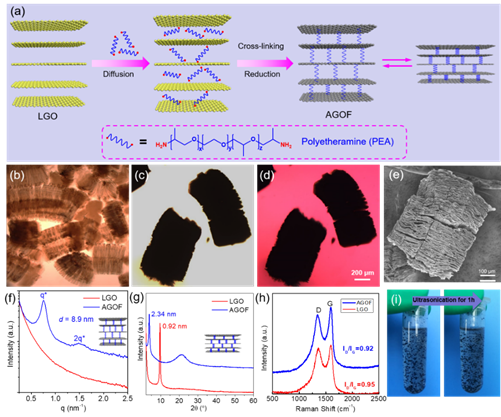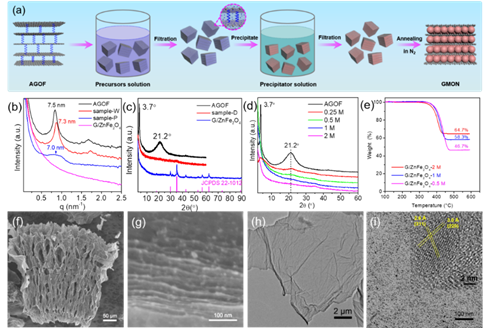 +565 975 658
+565 975 658
 info@premiumcoding.com
info@premiumcoding.com
 Monday - Friday, 8.00 - 20.00
Monday - Friday, 8.00 - 20.00
Despite two-dimensional (2D) heterostructures hold the great promise in designing integrated materials, the current synthesis strategies still confront the challenge of multilayer heterostructure construction and scale-up production. To address this issue, Lu`s group report a generalized host-guest strategy based on non-exfoliated layered graphene oxide (LGO), to construct graphene-based heterostructures that consist of multilayered, alternately aligned graphene and metal oxide nanosheets. The 2D-aligned graphene oxides and open interlayer spaces make LGO an ideal platform to create periodic 2D host framework. Polyetheramine oligomers were used to covalently bond the adjacent graphene oxides. The extended chain conformation endows the resulting accordion-like graphene oxide frameworks with good structural stability, periodicity and enlarged interlayer space. Owing to the high affinity of the open and well-arranged 2D channels toward guest precursors, a variety of high-quality heterostructures can be synthesized. Furthermore, a variety of exfoliated, ultrathin MO nanosheets can also be prepared by removing the graphene skeleton. The flexible interlayer chemistry presented in this work pave a way toward the synthesis of a large family of graphene-inorganic/organic 2D heterostructures.
Key points of this work:
- Synthesis and structure of AGOF.
Non-exfoliated layered graphene oxide (LGO) was used to prepare AGOF, the precursor of graphene-based heterostructures. LGO consists of well-aligned GO nanosheets that contain abundant oxygen functional groups and similar sheet size and nanometer-scale interlayer spacings. The flexible interlayer chemistry makes LGO a unique precursor in designing 2D confined space. Inspired by the reticular chemistry, in which a well-defined periodic structure is usually composed of building blocks (such as GO units in LGO) and building bonds (covalent linker between two GO units), Lu`s group propose a precisely adjusting method to control the 2D interlayer space of AGOF through crosslinking between adjacent GO sheets. The typical synthetic process of AGOF is shown in Figure 1a. Linear polyetheramine (PEA, molecular weight 2 kg/mol, named as PEA-2k) was used as a linker, because its amino end groups can react with the epoxy groups on GO through the ring-opening addition reaction. This enables the GO sheets in LGO to be immobilized to form structurally stable AGOF and avoids dissociation.

Figure 1. Synthesis and structure of AGOF.
- Synthesis of alternately aligned heterostructures.
AGOF provides a platform to synthesize diverse graphene-based heterostructures due to its highly accessible interlayer space. The extended chain con-formation and hydrophilic nature of PEA allow a variety of metal ions to diffuse into the interlayer space and then transform to layered metal hydroxides or oxides. Employing AGOF and in-situ precipitation re-action, we synthesized several graphene-based, alter-nately aligned metal oxide heterostructures, including ZnFe2O4, TiO2, Fe2O3, Mn2O3 and Co3O4. The corresponding process is illustrated in Figure 2a. To control the precipitation reaction only to occur within the interlayer space, the salt solution outside AGOF was removed through filtration after the metal salt sufficiently diffusing into the interlayer. The subsequent precipitation reactions and the chelating effect of ether bonds (of PEA) to metal ions enable the fast formation of layered metal hydroxides within AGOF. Taking the study of AGOF/ZnFe2O4 heterostructure (G/ZnFe2O4) as an example, the structural evolution of graphene-based heterostructure during synthesis was analyzed (Figure 2b-e). The obtained G/ZnFe2O4 heterostructure maintained the organ-like skeleton morphology well (Figure 2f and g) and showed good structural stability. This is mainly due to the interlaminar bridging PEA molecular chain, which also promotes the uniform distribution of metal salt ions to form regular, smooth surface ZnFe2O4 nanometer tablets (Figure 2h-j).

Figure 2. Synthesis of alternately aligned heterostructures.
Together, Lu`s group demonstrated a generalized method to con-struct layer-wise, alternately aligned graphene-based 2D heterostructures via the construction of highly periodic graphene-oxide framework with 2D open channels.
The above results were published in SCIENCE CHINA Materials. Ruan, Y. §; Zhao Z. §; Zhang J.*; Lu H.* Alternately Aligned 2D Heterostructures Enabled by d-Spacing Accessible, Highly Periodic Accordion-Like Graphene Oxide Frameworks (Awaiting Production Checklist). The first authors of the work are Dr. Ruan Yingbo, Zhao Zedong, and corresponding authors are Dr. Zhang Jiajia and Professor Lu Hongbin.
Get to know us better now!

Wechat:FDUMMers
Search!
Search across our website
Revenant @ 2018 by fudan | All Rights Reserved
Powered by Weicheng

